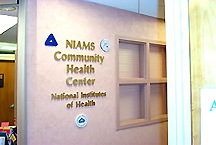
| T H E N I H C A T A L Y S T | M A Y – J U N E 2003 |
|
|
|
THE AGONY AND THE ECSTASY:CLINICAL RESEARCH AT NIH |
by Fran Pollner |
 |
|
NIH
provides medical services while conducting clinical research at a NIAMS-run
community clinic
|
The public’s substantial investment in the new Clinical Research Center (CRC) must be matched by outstanding contributions to the country’s clinical research needs, NIH Director Elias Zerhouni challenged a critical mass of NIH investigators and clinical directors (and others) at the start of a daylong retreat March 21.
"NIH cannot be everything to everybody," but must select "top priorities," Zerhouni said, noting that 75 percent of health-care costs today is attributable to chronic disease.
He charged the assembly with crafting a new vision for the new CRC and with defining a "compelling" role for the NIH intramural research program in the translation of basic science discoveries that can continue to make a difference in human health.
"This is a leadership retreat to determine the right things to do," Zerhouni said, adding that the right things would necessarily be "trail blazing" and not "me, too" research.
The retreat was structured to review some of the exceptionally innovative and successful elements of the intramural clinical research program and to turn a critical eye on some of the burdensome realities that keep it from reaching optimal performance.
In his opening remarks, Deputy Director for Intramural Research Michael Gottesman reminded participants that the retreat was meant to be neither a "gripe session" nor a "pep rally" but a concept-oriented meeting that would lay the groundwork for the formation of working groups and an ensuing series of workshops aimed at:
![]() Defining and removing obstacles to clinical research at NIH
Defining and removing obstacles to clinical research at NIH
![]() Identifying mechanisms for collaborative, innovative clinical research unique
to the CRC milieu that will result in the development of novel therapies for
daunting diseases and for conditions that exact a huge public health toll
Identifying mechanisms for collaborative, innovative clinical research unique
to the CRC milieu that will result in the development of novel therapies for
daunting diseases and for conditions that exact a huge public health toll
![]() Defining the goals of the CRC and how best to measure success
Defining the goals of the CRC and how best to measure success
Central to achieving optimal use of the CRC, everyone seemed to agree, is attracting requisite numbers of clinical investigators and patients to NIH.
Welcome to the Clinical Center
"There’s no other hospital like it," said CC Director John Gallin, quoting what is actually the little-known motto of the Clinical Center. Patients, he said, have plenty of reasons to seek involvement in clinical research at NIH—free care, with travel expenses paid, if necessary; a superb nurse-to-patient ratio; highly educated nurses; and on-site "boutique" support services. The patients on protocol at the CC are also "invested in the clinical research process," Gallin said, noting that he meets quarterly with a patient advisory group.
Extramural clinical investigators also have plenty of reasons to seek involvement in clinical research at NIH, said Carl Barrett, director of the NCI Center for Clinical Research. "The CC accounts for more than half of NIH-funded general clinical research beds in the country. It’s a technological center of excellence, offering proteomics, imaging, specialized therapeutic delivery systems, pharmacogenomics, and combination therapies," Barrett said. "And we have a national clinical research center with open access to clinical protocols and specialized early-phase studies."
Descriptions of NIH programs (see below) that are generating useful collaborations and exciting research capped off the morning.
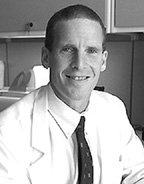 |
|
Howard
Fine
|
The Brain Tumor Program
Three years ago, NIH recruited Howard Fine as chief of the NCI Neuro-Oncology Branch. His mandate was to launch the Brain Tumor Program (BTP), a collaboration of NCI, NINDS, the extramural community, and the private sector.
The BTP mission is to develop novel therapeutic and diagnostic modalities for children and adults with central nervous system malignancies and to be a resource for patients and physicians.
The program is working "tremendously well," Fine said.
Before 2000, fewer than 30 patients a year with primary brain tumors were seen at NIH; last year, the BTP saw more than 300 such patients and anticipates about 400 this year; there are 13 clinical trials that are either active or going through the IRB-approval process; more than 20 new compounds are in preclinical or clinical trials; the program trains five neuro-oncology research fellows a year (for three years); and it has or is in the process of negotiating at least eight different CRADAs.
NIH can amass a critical number of patients for phase I/II trials at the Clinical Center, Fine said, and then return them to their communities to pursue conventional therapy. The BTP collaborates with area hospitals, including Johns Hopkins in Baltimore and George Washington and Children’s Hospital Medical Center in Washington. It is also an active member of the three (two adult, one pediatric) NCI-sponsored phase I/II clinical trial consortia of national brain tumor centers. It has also set up a consultation service and a multidisciplinary NIH-wide Brain Tumor Clinic on the 12th floor of the CC, with monthly care conferences. Free diagnostic consults out in the community also result in many patient referrals.
The program "is particularly appropriate for NIH," Fine observed, "because this is a tumor type not frequently seen in the community and for which standard options are limited."
"Although we inform all patients about optimal standard treatment, we don’t actually administer standard treatment here," Fine said. "Rather, we offer appropriate patients enrollment in clinical trials exploring novel anti-tumor agents such as EGFR [epidermal growth factor receptor] inhibitors and FTI [farnesyl transferase inhibitors]—and there are probably many scientists here at NIH working on research relevant to the BTP who just don’t know about us," he added, in a call for collaborators.
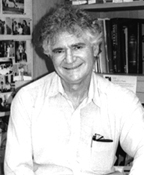 |
|
Ira
Pastan
|
Bench to Bedside—and Back
The notion that NIH is uniquely designed to be a testing ground for clinical applications of basic science discoveries is being realized in the five-year-old Bench-to-Bedside program.
This model for translational research has yielded new diagnostic and therapeutic approaches to a variety of both complex and common conditions (see The NIH Catalyst, "From Bench to Bedside Under the NIH Canopy," and accompanying stories, March-April 2002).
Ira Pastan, chief of the Laboratory of Molecular Biology, NCI, discussed his own transition 10 years ago from a basic scientist with a 30-year track record at NIH to a translational scientist whose intention "to do something useful in cancer" generated research in recombinant immunotox-ins that resulted in a Bench-to-Bedside project that yielded a therapy for drug-resistant hairy cell leukemia.
The site visit committee had deemed the research too risky and expensive, Pastan recalled, but the IRP did not, and the result was a great clinical success.
Alan Schechter, chief of the Laboratory of Chemical Biology, NIDDK, and Mark Gladwin, senior investigator in the CC Critical Care Medicine Department, were involved in several of the original Bench-to-Bedside awards that focused on sickle cell disease. These awards were important in the initiation of this collaboration, which subsequently involved others in NCI and NHLBI as well.
The goal of the work is to develop targeted delivery of nitric oxide by hemoglobin to improve regional blood flow in patients with sickle cell disease.
The CC, said Gladwin, "is a great place to develop protocols." Since the inception of the Sickle Cell/Nitric Oxide Therapeutics Program in 1998, the NIH’s National Center for the Study of Minorities and Health Disparities and Howard University and the Cardozo Clinic in Washington, D.C. (see section below, "Community Clinic: Gateway to Trials") have been collaborators.
The program, said Schechter, has truly been "bedside to bench to bedside."
It has also generated 21 published papers and 12 review articles and editorials; it has launched six active IRB-approved protocols, with two more pending; it has enrolled 335 patients in clinical studies; and it has completed 564 outpatient and 384 inpatient visits.
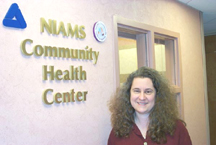 |
|
Barbara
Mittleman
|
Community
Clinic:
Gateway
to Trial
A NIAMS-run off-site clinic in the Cardozo community of Washington is examining health disparities and serving as a portal to state-of-the-art care for patients with unmet needs related to chronic rheumatic diseases. It’s also a portal to new patients and new protocols for NIH clinical investigators, while providing access to clinical trials for patients not typically in the loop. (See "NIAMS Turns Policy into Practice," The NIH Catalyst, January-February 2001).
A "symbiotic relationship hard to achieve elsewhere" has been created among NIH researchers, community physicians, and predominantly African-American and Hispanic-Latino patients, said Barbara Mittleman, PI for the NIAMS protocol to study the "Natural History of Rheumatic Disease in Minority Communities."
The program has accrued 465 patients since both the clinic and this first protocol were launched in 2001. "Every patient enrolled in the clinic is enrolled in the protocol," Mittleman said. "At the beginning, until we had established a reputation, gained community trust, and gotten greater community awareness of what we do, we had few patients. As the word got out that we are okay people and take good care of patients, the calls began to pick up to the current rate. In fact, the number of patients seen continues to rise on a monthly basis."
Patients were glad to sign on to a research protocol that provides the standard of care and access to resources like imaging that might not otherwise be affordable.
There are no experimental modalities in the natural history protocol, but patients can be offered entry into other NIH studies for which they may also be candidates. This "spillover into other IC protocols has already begun," Mittleman noted, and other NIAMS protocols are in development, some in collaboration with other institutes. The community, she said, sees the NIH clinic as a "tremendous complement" to existing facilities and an excellent venue for clinical research training.
In an ensuing discussion focused on the benefits of such natural history of disease protocols, NIAID Clinical Director Cliff Lane noted that a protocol to study the natural history of HIV disease not only has scientific merit but also meets a critical requirement of the NIAID infectious disease fellowship program to retain its ACGME (graduate medical education) accreditation.
Carefully crafted natural history studies of common diseases for which therapy exists but is not effective enough is a fine means to accrue sufficient numbers of patients to yield meaningful findings, observed Dave Harlan, chief of the NIDDK Transplantation & Autoimmunity Branch. He sees such studies as a clinical research niche for NIH, in addition to studies of rare diseases with poor or no therapies and diseases that disproportionately affect the underserved.
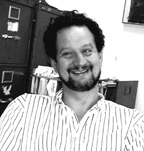 |
|
Toren
Finkel
|
Novel
Cardiac Surgery:
Another
NIH Niche
In 1990, NHLBI’s cardiac surgery program was closed for lack of patient volume. By the time Toren Finkel arrived at NIH in 1992, the NHLBI interventional cardiology program had "dissipated" for lack of cardiac surgery.
But interventional cardiology is now making a comeback at NIH, thanks to the reinstitution of cardiac surgery through the creation of a three-way partnership between Johns Hopkins University in Baltimore, Suburban Hospital in Bethesda, and the IRP, said Finkel, now chief of the Cardiovascular Branch and its cellular and molecular biology section.
This partnership encompasses an ongoing cardiology fellowship at Hopkins and an imaging program at Suburban run by Bob Balaban, chief of the Laboratory of Cardiac Energetics, NHLBI. "The research-driven component will be under the NIH umbrella," Finkel said.
While the partners are "still working out" the details of how decisions will be made regarding which patients will receive standard of care and which patients will be offered a protocol, discussions regarding where surgery will be done are pointing to Suburban—where volume and quality are high—as the site for "bread and butter" surgery.
"It’s been proposed that the more novel research surgery might be routed to the CC," Finkel said. "If agreed upon, this could be an NIH niche."
In the ensuing discussion, Henry Masur, chief of the CC’s Critical Care Medicine Department, cautioned against "just taking care of the problem specified in the protocol and not the whole patient," a practice, he said, that is not limited to any one institute and that frustrates the wishes of patients and referring physicians. Others expressed similar concerns.
Masur also advised that younger investigators with clinical programs be accorded more space in the new facility—and that efforts be made to correct hospital underutilization in general.
Mittleman suggested that NIH researchers generate hypotheses and think of new clinical trial paradigms that would address functional assessment and quality-of-life issues over the long term.
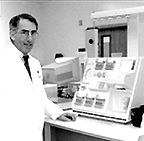 |
|
Harvey
Klein
|
Partnering
CC Transfusion Medicine Department Chief Harvey Klein recounted a history of interactions with the private sector that have produced an array of ground-breaking instruments in the transfusion field. Over the past 10 years, he said, the department has negotiated 14 CRADAs and numerous material transfer agreements.
He described two win-win agreements with Baxter Healthcare of Deerfield, Ill., that resulted in a core-processing facility and pioneered novel cell separation and processing techniques, including mononuclear cell apheresis. "Baxter got the products, and we got extremely useful technology," Klein observed (see "Cell Processing Facility Debuts," The NIH Catalyst, November-December 1997).
Another "marvelous example of partnering," NCI’s Barrett said, is the collaboration of NCI’s Lance Liotta and FDA’s Emanuel Petricoin and their colleagues in studies of molecular profiling and individualized therapies for patients with ovarian and prostate cancer. (For background info, see "Beyond Genomics to Clinical Proteomics," Part 1 and Part 2, The NIH Catalyst, March-April 2001 and May-June 2001).
At the NCI Center for Clinical Research, Barrett added, the Medical Oncology Clinical Research Unit provides interdisciplinary clinical research and training and serves as an "alpha site" for protocol development and standardization. Extramural basic scientists often join up with intramural clinical investigators; collaborators come from both academia and industry, he said.
The Afternoon and Beyond
The bag-lunch and afternoon
sessions of the retreat addressed choosing relevant measures of success and
overcoming clinical research barriers related to recruitment, career development,
infrastructure, and bureaucracy and regulation (see "Obstacles
on the Path" below)—all to be further pursued in ongoing workshops.
![]()
OBSTACLES ON THE PATH TO CLINICAL RESEARCH |
||
The Visible Shield "The brick wall is the regulatory process." For Steve Rosenberg, NCI’s chief of surgery for 26 years and PI on dozens of protocols, there’s no greater impediment to translational research today than the multilayered review-committee bureaucracy that now stands between a pressing scientific question and a clinical protocol aiming to answer it. Many attendees at the Clinical Research Retreat March 21 nodded in recognition as Rosenberg presented what he described as a typical example of the roadblocks placed in the way of launching what was a high-priority protocol examining autologous cell transfer as a new approach to advanced metastatic cancer. From July 2001 to the day of the retreat nearly 20 months later, the protocol had been bounced back and forth between an alphabet soup of review committees—PRMC, OBA, IBC, IRB, and CTEP (Protocol Review and Monitoring Committee, Office of Biotechnology Activities, Institutional Biosafety Committee, Institutional Review Board, and Cancer Therapy Evaluation Program)—and the investigators. During this time, the protocol accrued more than 200 stipulations as each rewrite and resubmission inspired additional stipulations from another, previously satisfied, committee. New members coming on to committees in the middle of this protracted review would further complicate the process. "The enemy is us," Rosenberg said, noting that he hadn’t even brought the FDA into the picture he was presenting. Moreover, he said, the investigators submitted an amendment to a previously approved protocol so they might recruit additional patients to that one while waiting to begin the new one. Submitted last October, the amendment had yet to be okayed. "We’re getting 100 referrals a day and can accept no one," Rosenberg commented. "In the last two and a half years, we’ve had 30 audits of our tumor immunology protocols; we have 13 full-time people in the surgical unit just to to keep us in compliance; we have four PIs. I spend one day a week exclusively to keep us in regulatory compliance." He asserted that each of the review groups does essentially the same thing, that the same risk-benefit considerations are applied to patients with terminal conditions as to healthy volunteers, and that the review process has evolved into an albatross that often dilutes the science, delays the pursuit of answers critical to patients, and discourages the pursuit of clinical trials in general and the involvement of young investigators in particular. He pointed to one of his especially dedicated and gifted postdocs whose career has been put "on hold" during this 20-month hiatus in his main research pursuit. "We are losing a generation of translational investigators," Rosenberg warned. Tom Waldmann, chief of the NCI Metabolism Branch, noted that investigators such as himself and Rosenberg, who typically bring to trial novel therapeutics developed in their own labs, have the rockiest trip through the protocol-approval process. Things are a bit smoother, he said, when the agent being tested is supplied by a drug company. There is a general perception across NIH, however, that the protocol review and approval process has become increasingly burdensome, Deputy Director for Intramural Research Michael Gottesman said, citing responses to an IRP survey sent to 568 PIs, institute directors, and scientific and clinical directors. Most people indicated that NIH is an excellent venue for clinical research, with a high level of support from the leadership, but many from the smaller institutes especially cited a need for more resources related to protocol coordination and data management. Hierarchy A dominant concern among retreat participants was the status accorded individuals whose primary focus is clinical research. There is a perception—not borne out by data supplied by the Central Tenure Committee—that clinical investigators do not fare as well as basic scientists on the tenure track and that they are less likely to even be put on that track. http://www1.od.nih.gov/oir/sourcebook/comm-adv/ctc.htm Several speakers commented that designations like "fellow" and "staff clinician" are not acceptable to many MD/PhD applicants for clinical research slots and have actually been the reason for loss of potential recruits. Gottesman noted that one of the major post-retreat working groups will focus on clinical investigator training and recruiting. |